Seven Against Thebes › Lascaux Cave » Ancient origins
Articles and Definitions › Contents
- Seven Against Thebes › Antique Origins
- Lascaux Cave › Ancient History
Ancient civilizations › Historical and archaeological sites
Seven Against Thebes › Antique Origins
Definition and Origins
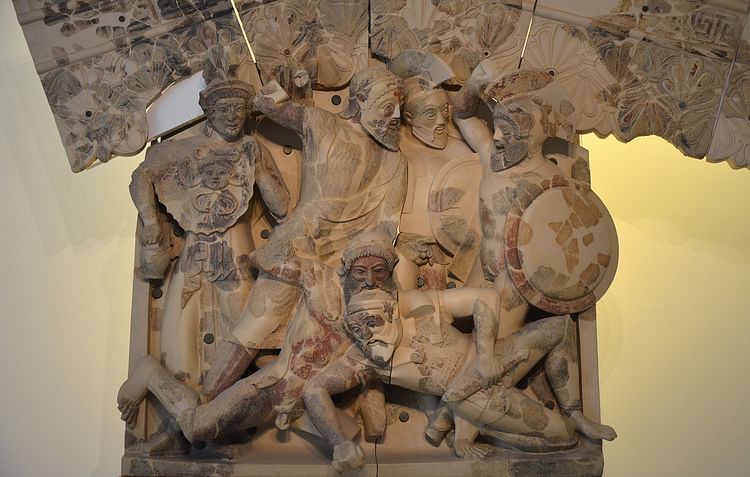
Seven Against Thebes is the third part of a trilogy written by one of the greatest of the Greek tragedians, Aeschylus in 467 BCE, winning first prize in competition at Dionysia. Unfortunately, only fragments of the first two plays, Laius and Oedipus and the accompanying satyr drama Sphinx remain. Based on the well-known ancient Greek myth surrounding King Oedipus of Thebes, Seven Against Thebes centers on this rivalry between Eteocles and Polynices, the two sons of Oedipus, fulfilling the curse of their father, never being able to settle their dispute and, in the end, falling by each other's hand. As evident with his most famous work Oresteia, Aeschylus may well have been the only tragedian to treat his trilogies as a single drama. This practice is evident in Seven Against Thebes where he makes a number of references to events from the first two plays.
AESCHYLUS
Considered the father of Greek tragedy, Aeschylus was born around 525 BCE into an aristocratic family of Eleusis, an area west of central Athens. A proud Athenian, he fought against the Persians at the Battle of Marathon in 490 BCE where his brother was killed. Some scholars claim he may have also fought at the Battle of Salamis in 480 BCE. He began writingabout this same time, winning his first victory in 484 BCE. Of his over 90 plays only six have survived – the authorship of a seventh Prometheus Bound is in question. He was best known for his use of the chorus and introduction of a second speaking actor thereby allowing plot development to be given more freedom. His two sons, Euaion and Euphorion, were both playwrights.

Aeschylus
Historian Norman Castor in his book Antiquity said that the purpose of Aeschylus's dramas was not to tell a story but to explore a problem. Classicist Edith Hamilton in her The Greek Way said he was the first poet to grasp the “bewildering strangeness of life” (182). She added that he was profoundly religious but somewhat radical, pushing aside the trappings of traditional Greek religion. The gods in his plays are seen as shadows, “questioning how a god can be considered just when people are allowed to suffer” (193). Late in life, Aeschylus traveled to Sicily where he would continue to write. He died there around 456 BCE.
THE MYTH
Most people in the audience would have been well-aware of the myth surrounding Oedipus and the curse of King Laius.However, to fully understand and appreciate the play the casual observer had to understand the plight of the doomed family of the king and the legend surrounding the tragedy of Oedipus. Prior to his birth, his father, King Laius, is foretold by an oracle that his son will one day kill him. To avoid this tragedy the baby Oedipus is sent away with orders to be killed. Unfortunately, the soldier sent to perform the deed could not, and by a stroke of luck, the child is raised by the king of Corinth and his wife.Years later, an adult Oedipus returns to his birthplace of Thebes and unknowingly fulfills the prophecy – killing his father and marrying his mother. Eventually, Oedipus, now the king of Thebes, learns of his sinful deed, blinds himself, and goes into exile.Along with his daughter, Antigone, he wanders as an outcast for many years until settling in Athens at the request of King Theseus. Prior to his death, he places a curse on his two sons; they will never be able to settle their differences and will die in battle. Seven Against Thebes centers on this rivalry between Eteocles and Polynices, the two sons of Oedipus. Although mentioned by name, Polynices does not appear or speak in the play.
ETEOCLES, THE LAST HOPE OF THEBES, FIGHTS HIS BROTHER AT GATE SEVEN WHERE BOTH ARE KILLED.
After the exile of Oedipus, the brothers agree to share the throne of Thebes; each would serve alternate one-year reigns.Eteocles chose to rule first, but at the end of his year refused to relinquish the throne to his brother, forcing Polynices to go into exile. In retaliation for his brother's treachery, Polynices aligns himself with King Adrastus of Argos, and a war ensues.Surrounded by the Argives, Eteocles is forced to do battle, and one by one, he sends his seven bravest champions outside the seven gates of Thebes against the best seven of Argos. With the war at a stalemate, Eteocles, the last hope of Thebes, fights his brother at gate seven where both are killed. The attackers are repelled, and the war ends. As with the Sophocles play, Antigone attempts to bury her brother Polynices (he is considered a traitor), despite the warnings of the Theban leadership.Although not mentioned in the play, according to the legend, the next generation of Argos returns to battle Thebes and is victorious.
CHARACTERS
Until the very end when Antigone and Ismene make their appearance, much of the play is spent with Eteocles speaking to the chorus. Therefore, there are relatively few characters:
- Eteocles
- Antigone
- Ismene (non-speaking)
- a messenger
- a herald
- and, of course, the chorus.
THE PLOT
The play opens with Eteocles confronting a large crowd of concerned Thebans. It is obvious that Polynices and his fellow Argives are gathered outside the walls of Thebes preparing for battle. The citizens have come to their king for reassurance. He speaks to them in a tone of comfort. He pleads with them to keep the altar, help the children, and lastly to help mother Earth.He informs them that a prophet has foretold that the enemy plans an assault, so they must tend to the gates and towers. In an attempt to ease their worries, he has sent spies and scouts to the enemy.
A messenger enters to tell Eteocles of the “fierce” seven commanders approaching the gates and advises him to “barricade your town before the blast of Ares strikes it in storm: we already hear the roar of the armed land wave” (Grene, 72). The nervous king prays to the gods to protect his city. The chorus is troubled, asking who will protect them, who will be their champion. What god or goddess will shelter them? Speaking of the approaching enemy, they exclaim:
Seven proud captains of the host, with harness and spear, have won their place by lot; they stand champions at seven gates. (75)
They shout to Zeus, to Apollo and to Athena. Speaking to the chorus, Eteocles is angry and says there are many in the city who are afraid, accusing them of being spiritless cowards. He insults them by calling them all a tribe of women. The enemy is gaining strength. If the people fail to obey his orders - both men and women - they will be sentenced to death. “Obedience is mother to success and wife of salvation.” (78) He charges the chorus not to allow the citizenry to become cowards, pray that the towers hold them off, be quiet and not overly fearful. The chorus leader is concerned and frightened:
Our city groans from its foundation, we're surrounded.... I'm afraid: the din at the gates grows louder. (79-80)
Eteocles tries to console him, telling him that it is not for him to worry and, again, asks him not to speak of what he hears to the city. The chorus leader remains fearful, adding that he will not be a slave. To the chorus Eteocles speaks of his plans:
I will take six men, myself to make the seventh, and go to post them at the city's gates, opponents of the enemy, in gallant style. (81)
He exits. The chorus speaks aloud of the chaos behind the city walls; screams, roving bands of pillagers. Eteocles returns just as a messenger arrives with news of the enemy; each Argive champion stands at his appointed gate. He asks the king who shall be sent to the first gate, who deserves their trust. Eteocles listens as the messenger speaks of the might of first enemy champion but quickly dismisses the threat, no equipment of man will make him tremble. He chooses his first champion to face the enemy.
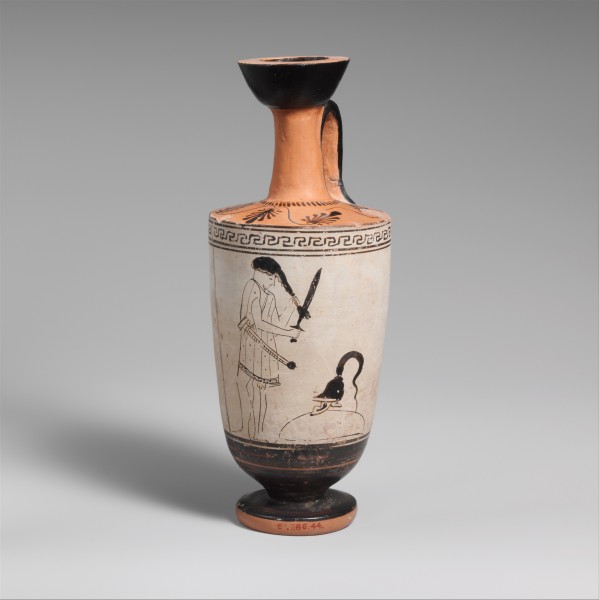
Attic Oil Flask Depicting a Scene from Seven Against Thebes
One by one, Eteocles selects the champions to face the enemy. They all watch as the men do battle at the third, fourth, fifth, and sixth gates. Finally, the messenger speaks to Eteocles. At the seventh gate is his brother, Polynices.
Hear how he curses the city and what fate he invokes on her. He prays that once his foot is set upon our walls, once he is proclaimed the conqueror of this land, once he has cried a paean of triumph in its overthrow, he then may choose to fight with you and killing encounter his own death beside your corpse. (93)
Eteocles cries out that his father's curse has been fulfilled. He asks for his greaves to shield him. Although the chorus leader begs him not to go, Eteocles insists that he must. Eteocles exits. The messenger soon returns. At the seventh gate, the brothers have died by each other's hand; the curse has come true.
With brothers' hands they achieved their mutual murder. The city is saved, but of the royal pair the ground has drunk the blood shed each by each. (101)
Attendants bring in the bodies of the two slain brothers. A herald remarks:
It is duty to declare to you counselors of the people, the resolves already taken … Our lord Eteocles for his loyalty it is determined to bury in the earth he so loved. (108)
However, the traitor Polynices must be cast out unburied. As with Sophocles' play Antigone declares:
… yet will I bury him and take the danger on my head alone when that is done. He is my brother. I am not ashamed of this anarchic act of disobedience to the city. (109)
The herald stands fast, forbidding her, but she remains resolute. Antigone, with half the chorus, stands with the body of Polynices while Ismene, with the second half, stands with the body of Eteocles. They all leave to bury the bodies.

Antigone with Polynices' Body
LEGACY
Aeschylus's influence would live long after him, even having a profound effect on his fellow tragedians. References to Seven Against Thebes appear in both Aristophanes ' Frogs and Euripides ' Phoenician Women. The play would survive well into the Byzantine and Renaissance eras. Unfortunately, its present-day form may not be the same one penned by Aeschylus.Many scholars believe that parts of the play were rewritten years later to keep it in line with Sophocles' Antigone, a play presented 15 years after Aeschylus's death. This is quite evident is the climax; Antigone only appears in the final lines of the play to voice her concern about Polynices' unburied body. Despite this rather abrupt conclusion, the play has stood the test of time and influenced not only his fellow tragedians but others well into the Renaissance.
Lascaux Cave › Ancient History
Definition and Origins
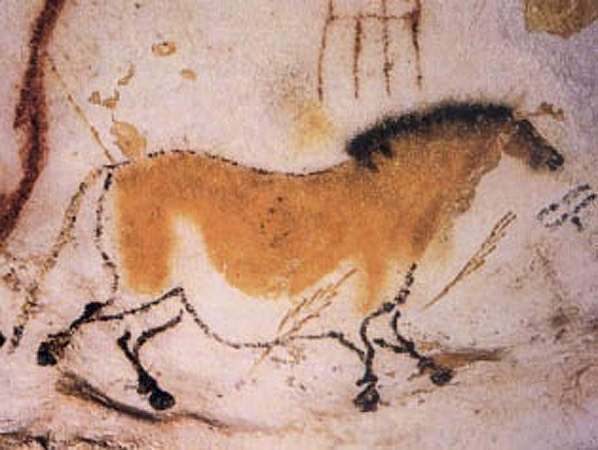
Lascaux Cave is a Palaeolithic cave situated in southwestern France, near the village of Montignac in the Dordogne region, which houses some of the most famous examples of prehistoric cave paintings. Close to 600 paintings – mostly of animals - dot the interior walls of the cave in impressive compositions. Horses are the most numerous, but deer, aurochs, ibex, bison, and even some felines can also be found. Besides these paintings, which represent most of the major images, there are also around 1400 engravings of a similar order. The art, dated to c. 17,000 – c. 15,000 BCE, falls within the Upper Palaeolithic period and was created by the clearly skilled hands of humans living in the area at that time. The region seems to be a hotspot; many beautifully decorated caves have been discovered there. The exact meaning of the paintings at Lascaux or any of the other sites is still subject to discussion, but the prevailing view attaches a ritualistic or even spiritual component to them, hinting at the sophistication of their creators. Lascaux was added to the UNESCO World Heritage Sites list in 1979, along with other prehistoric sites in its proximity.
THE DISCOVERY
On 12 September 1940 CE four boys examined the fox hole down which their dog had fallen on the hill of Lascaux. After widening the entrance, Marcel Ravidat was the first one to slide all the way to the bottom, his three friends following after him.After constructing a makeshift lamp to light their way, they found a wider variety of animals than expected; in the Axial Gallery they first encountered the depictions on the walls. The following day they returned, better prepared this time, and explored deeper parts of the cave. The boys, in awe of what they had found, told their teacher, after which the process towards excavating the cave was set in motion. By 1948 CE the cave was ready to be opened to the public.
OCCUPATION BY HUMANS
Around the time Lascaux cave was decorated (c. 17,000 – c. 15,000 BCE), anatomically modern humans ( homo sapiens ) had been well at home in Europe for a good while already, since at least 40,000 BCE. Following the archaeological record, they seem to have been abundantly present in the region between southeastern France and the Cantabrian Mountains in the north of Spain, which includes Lascaux. The cave itself shows only temporary occupation, probably linked to activities related to creating the art. However, it is possible that the first couple of metres of the entrance vestibule of the cave – the space the daylight could still reach - might have been inhabited.
THE ART AT LASCAUX WAS BOTH PAINTED ON & ENGRAVED INTO THE UNEVEN WALLS OF THE CAVE, THE ARTISTS WORKING WITH THE EDGES & CURVES OF THE WALLS TO ENHANCE THEIR COMPOSITIONS.
From the finds originating from the cave, we know that the deeper parts of the cave were lit by sandstone lamps that used animal fat as fuel, as well as by fireplaces. Here, the artists worked in what must have been smoky conditions, using minerals as pigments for their images. Reds, yellows, and blacks are the predominant colours. Red was provided by hematite, either raw or as found within red clay and ochre; yellow by iron oxyhydroxides; and black either by charcoal or manganese oxides.The pigments could be prepared by grinding, mixing, or heating, after which they were transferred onto the cave walls.Painting techniques include drawing with fingers or charcoal, applying pigment with 'brushes' made of hair or moss, and blowing the pigment on a stencil or directly onto the wall with, for instance, a hollow bone.
The catch is that there are no known deposits of the specific manganese oxides found at Lascaux anywhere in the area surrounding the cave. The closest known source is some 250 kilometres away, in the central Pyrenees, which might point to a trade or supply route. It was not uncommon for humans living around that time to source their materials a bit further afield, tens of kilometres away, but the distance in question here may indicate that the Lascaux artists put in a superb amount of effort.
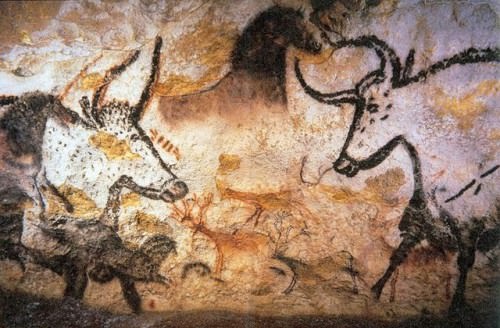
Cave Painting in Lascaux
Besides the paintings, many tools were found at Lascaux. Among these are many flint tools, some of which display signs of being used specifically for carving engravings into the walls. Bone tools were also present. The pigments used at Lascaux contain traces of reindeer antler, most likely introduced either because antler was carved right next to the pigments or because it was used to mix the pigments into water. The remains of shellfish shells, some of them pierced, tie in well with other evidence of personal adornment found among humans living in Europe during the Upper Palaeolithic.
THE ART
The art at Lascaux was both painted on and engraved into the uneven walls of the cave, the artists working with the edges and curves of the walls to enhance their compositions. The resulting impressive displays depict mainly animals, but also a significant amount of abstract symbols, and even a human. Of the animals, horses dominate the imagery, followed by deer and aurochs, and then ibex and bison. A few carnivores, such as lions and bears, are also present. The archaeological record of the area shows that the depicted animals reflect the fauna that was known to these Palaeolithic humans.
The entrance of the cave leads away from the daylight and straight into the main chamber of the cave, the Hall of the Bulls.Aptly named, this space contains mostly aurochs, a now extinct type of large cattle. In a round dance, four large bulls tower above fleeing horses and deer, the relief of the walls serving to emphasise certain parts of the paintings. The animals are shown in side-view, but with their horns turned, giving the paintings a liveliness indicative of great skill. So far, these animals are easily identifiable, but others are less clear-cut. See, for instance, the seemingly pregnant horse with what looks like one horn on its head. Another mysterious figure is depicted with panther skin, a deer's tail, a bison's hump, two horns, and a male member. Creative minds have suggested it may be a sorcerer or wizard, but what it really represents is hard to determine.

Wounded Bull, Man & Bird, Lascaux Cave
Beyond the Hall of the Bulls lies the Axial Gallery, a dead-end passage, but a spectacular one at that. It has been dubbed the 'Sistine Chapel of Prehistory,' as its ceiling is home to several eye-catching compositions. Red aurochs stand with their heads forming a circle, while the main figures of the Gallery stand opposite one another: a mighty black bull on one side, a female aurochs on the other, seemingly jumping onto some sort of lattice that has been drawn underneath her hooves. There are horses in many shapes, including one known as the 'Chinese horse,' with its hooves depicted slightly to the back, demonstrating a use of perspective far ahead of its time. Towards the back of the passage, a horse gallops with its mane blowing in the wind while its companion falls over with legs in the air.
A second exit from the Hall of the Bulls leads to the Passage, which houses mostly engravings but also some paintings of a large variety of animals. In the Nave, following the Passage, a large black bull as well as two bisons stand out because of their wild power, seemingly fleeing. Opposite, a freeze shows five deer who appear to be swimming. After the Nave, the Chamber of Felines throws some predators into the mix, with engravings of lions dominating the room. In another branch of the cave, the room known as the Shaft adds some more material for discussion. Here, besides the wounded bison with its intestines sprawling out from its gut, are a woolly rhinoceros, a bird on what might be a stick, and a naked man with an erect member.This image clearly tells a story, although it is hard to be certain exactly what that story might be.
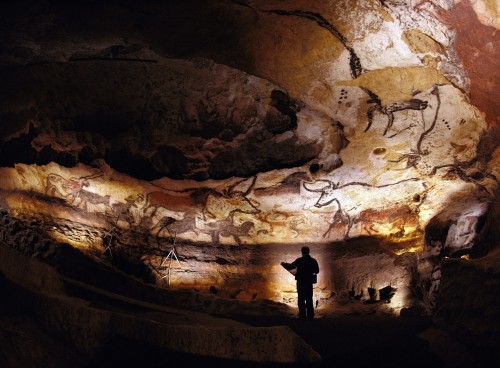
Lascaux II Cave Today
THE CAVE TODAY
The original cave was closed to the public in 1963 CE after it became clear that the many visitors caused, among others, the growth of algae on the cave walls, dealing irreparable damage to the paintings. Despite the closure, fungi have spread within the cave, and efforts to control these issues and protect the art are ongoing. Those looking for an alternative experience can visit Lascaux II, a replica of the Great Hall of the Bulls and the Painted Gallery sections, which was opened in 1983 CE and is located at a mere 200 metres from the original cave.
See other Related Contents ››
LICENSE:
Article based on information obtained from these sources:with permission from the Website Ancient History Encyclopedia
Content is available under License Creative Commons: Attribution-NonCommercial-ShareAlike 3.0 Unported. CC-BY-NC-SA License